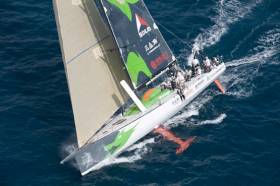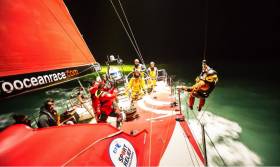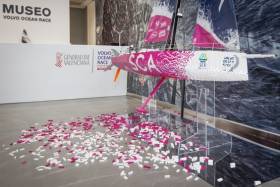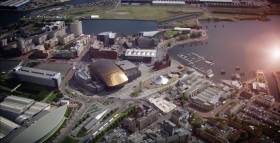Displaying items by tag: Volvo Ocean Race
Volvo Ocean Race Stays in Alicante
Alicante’s regional government, Generalitat Valenciana, announced today it had agreed a commitment to keep the Volvo Ocean Race in Alicante for two more editions.
The deal will see Alicante maintain its position as the start port for the 14th and 15th editions of the race (2020-21 and 2023-24, under the current format of a race every three years), as well as remain the base for the race headquarters and the Volvo Ocean Race Museum during this period.
The current agreement expires at the end of 2018. Speaking at a press conference alongside the Mayor of Alicante, Gabriel Echávarri, the President of Generalitat Valenciana, Ximo Puig, said: “The Volvo Ocean Race is one of the greatest promotional tools for the Valencian region.
“Without doubt, it is the best instrument for the positioning of the city of Alicante, worldwide.”
He continued: “It's a great event for people in Alicante - an event with a global impact. From a commercial point of view, we want it to display Alicante to the whole world.
“It’s a difficult decision, given the economic situation of the region, but it’s the right decision, as we firmly believe that the economic and cultural promotion of Alicante is in the general interest,” said Puig.
Antonio Bolaños Lopez, acting CEO of the Volvo Ocean Race, said: “We are very satisfied with the support from Generalitat Valenciana, with their willingness to negotiate and to sign the agreement.
“We are ready to develop projects beneficial for the city and the region.”
The Volvo Ocean Race had an economic impact of 274 million euros in the Valencian region (plus 47.6 million euros in the rest of Spain) and generated the equivalent of 4,833 full time jobs in the region from 2008 to 2014, according to an economic impact study carried out by PricewaterhouseCoopers (PwC).
Alicante has been the start port for the last three editions of the round-the-world race (2008-09, 2011-12 and 2014-15) and will be once again in 2017-18 when the fleet visits Lisbon as its first leg destination.
According to the terms of the new contract, Alicante would also host the start in the following two editions. The race headquarters moved to Alicante in 2010 and the Volvo Ocean Race Museum opened in 2012.
With a free entry policy, the museum received 50,488 visits in 2015, of which 44% were international visits, and 59,456 visits in 2014 (36% international).
#VOR - Lisbon in Portugal has been chosen as the destination for a flying start to the next edition of the Volvo Ocean Race in 2017-18.
Hailed by organisers as one of the most successful host cities of the VOR in recent years, Portugal’s capital city staged hugely popular stopovers in 2011-12 and 2014-15 following transatlantic legs.
But this time it's been have decided that a short, sharp ‘sprint’ leg from Alicante would be the ideal way to begin the round-the-world challenge.
Race organisers also announced yesterday (Tuesday 10 May) that a new Boatyard facility was opening with immediate effect in Lisbon to service the fleet for the next race and provide the base for an upgrade to all the Volvo Ocean 65 boats from October this year.
The Boatyard at Lisbon will complement the established maintenance centre in Alicante that will continue to be available for teams as their Mediterranean training and support base.
“We have a double reason to celebrate our close ties with the great maritime capital city of Lisbon today," said Antonio Bolaños López, acting chief executive of the VOR before Mark Turner takes the reins next month.
“Firstly, we know that Lisbon will provide a packed and vibrant host city for our fleet after a thrilling first leg from Alicante, ensuring the next race in 2017-18 will begin in real style.
“Secondly, Lisbon offers us the perfect location to set up a second Boatyard operation on top of the existing provision we enjoy in our home city of Alicante.”
Boatyard head Nick Bice said he was delighted to open a new centre for future teams, with perfect training conditions in the Atlantic so close by.
“Lisbon has endless possibilities for us," he said. "The building we’ll be using for The Boatyard is an old fish market. If you were to design and build a facility to undertake the upgrades to the boats, you wouldn’t be able to design it better than what’s already there in the docks in Lisbon.
“The training options are almost limitless. You can go up around the corner, around Cascais and be virtually guaranteed wind at any stage. Equally, you could train in the Tagus River to practise in light air scenarios.”
The fleet for the 13th edition in 2017-18 will be upgraded in the Lisbon facility later this year and early into 2017.
Lisbon joins Alicante, Cape Town, Hong Kong, Auckland, Newport in Rhode Island, Cardiff, Gothenburg and final destination city The Hague on the route for the 2017-18 race, with more cities to be announced in the coming weeks.
Hong Kong To Debut As Volvo Ocean Race Stopover Destination
#VOR - Hong Kong will host the Volvo Ocean Race for the first time when the event visits in February 2018 during the 13th edition.
In a press conference today (Wednesday 13 April), VOR organisers announced a unique collaboration with the Hong Kong Sailing Federation to bring the race to Hong Kong’s Victoria Harbour.
It is set to be the largest world-class sailing event ever staged in Hong Kong, already one of the world’s most prestigious sailing destinations.
The world’s premier offshore race will transform the old airport in Kai Tak, and introduce residents of Hong Kong to a wide range of race-related activities geared to educate as well as entertain both existing fans and newcomers to the race.
An in-port race will also be held in the port before the boats leave for the next leg.
Anthony Day, Council Member of the Hong Kong Sailing Federation, said: “This will go down in history as a milestone event for Hong Kong sailing and will provide a wonderful platform for us to engage more Hongkongers in the sport of sailing."
Antonio Bolaños Lopez, acting CEO of the Volvo Ocean Race before Mark Turner takes up the role later this year, added: “I am thrilled that the race is visiting one of the most beautiful ports in the world for the first time.
"We are delighted to welcome Hong Kong to the Volvo Ocean Race family and know that we will have a stopover that will be one of the highlights of the 2017-18 edition.
“I would like to pay special tribute to the Hong Kong Sailing Federation and the Hong Kong government for making our dreams of bringing the race here a reality.”
Hong Kong brings the confirmed list of stopovers so far for the Volvo Ocean Race 2017-18 edition to nine, which includes Alicante, Auckland, Cape Town, Cardiff, Newport in Rhode Island, Lisbon, Gothenburg and The Hague, which will host the finale after a successful pit-stop on the final leg of the 2014-15 race.
The Hong Kong stopover will mark the fourth time the Volvo Ocean Race has visited China, after Qingdao in the 2008-09 race and Sanya in the 2011-12 and 2014-15 competitions.
Mark Turner Appointed Volvo Ocean Race CEO
Mark Turner has been appointed Volvo Ocean Race CEO, stepping down after 23 years at the helm of global sports marketing company OC Sport.
The Briton, who competed in offshore sailing’s leading international event as a Whitbread Round-the-World sailor in 1989, and masterminded the Dongfeng Race Team project in the 2014-15 edition, will take up his new position in succession to Knut Frostad from June 7 this year.
Turner, 48, said: “There probably isn’t any other post in sailing that could have attracted me today after taking OC Sport through so many different areas of the sport over the last two decades.
“It is a significant responsibility for me to take over the leadership from Knut, who has done such an excellent job of transforming the race in to the sport’s biggest and most commercially viable top-level event.
“As the race with the most significant global footprint in both media and business-to-business terms, and a fascinating history dating back to 1973, there is a huge responsibility not only to the numerous stakeholders, Volvo, and the other team and event partners, but also to the sport of sailing in general. It’s a platform that can really help shape the future of the sport.
“I certainly hope I can add some value and vision to the excellent work of the great team already in place in Alicante, and through that, help to inspire and engage more and more fans, sailors and sponsors, in the future.”
Henry Stenson, chairman of the Volvo Ocean Race board, said he was delighted with the appointment.
“It has been a long and thorough process, but I know that in Mark we have found the right person to take on this very challenging role,” he said.
“We need a man with the expertise, determination and vision to take the event to the next stage after all the great work done by Knut, and Mark has all these attributes in abundance. The future under his guidance looks very exciting indeed.”
Turner has competed in many of the sport's leading events including the Transat Jacques Vabre and the Mini Transat, but really made his name in the sport by masterminding Briton Ellen MacArthur’s successful Vendée Globe race in 2001 when she finished second.
He then oversaw her breaking the solo circumnavigation of the world record in 2005, taking the sport to a wider audience than ever before, both in their native United Kingdom, but also around the world.
Turner went on to launch the very successful Extreme Sailing Series with OC Sport as well as many other leading adventure sports events.
He added: “My personal chapter with OC Sport is now ending, but the spirit and achievements will continue, I’m sure, with the strong team I’m leaving behind.
“It has been an honour to work with so many motivated and talented people over the years, and to have been able to use the sporting platforms we’ve created to inspire people from all walks of life.
“OC Sport has enabled me to challenge the norm and innovate in many areas – something that I’m sure the company will continue to strive to do.”
Turner has stepped down fully from OC Sport as both board director and shareholder.
Turner, who is also a very keen cyclist, swimmer and skier, will now undertake a period of leave before taking up his new responsibilities with the race, ahead of the 13th edition in 2017-18 which starts in October next year.
Short biography
Born: Isle of Wight, England in July 1967
1985-90 – Lieutenant, Seaman Officer, Royal Navy
1989-90 – Competed in Whitbread Round the World Race on British Defender
1989-92 – Operations, Sales and Marketing Director, Winning Winches
1992-98 – Marketing Director, Spinlock
1993-2016 – Founder and Executive Chairman, OC Sport
June 2016 – CEO, Volvo Ocean Race
2017-18 Volvo Ocean Race Finale At The Hague
The Hague, scene of an enormously successful pit-stop last year, has been chosen to host the finale of the Volvo Ocean Race 2017-18.
The Dutch stopover will be preceded by a midsummer stopover in Volvo’s home city of Gothenburg, setting up the crucial last leg to the Netherlands in June 2018.
The race’s outgoing Dutch COO, Tom Touber, announced the climax to the 13th edition in Scheveningen harbour at a press conference in The Hague on Wednesday.
“Today is a great day for sailing in general, but even more so for the Netherlands. It’s wonderful that the finale of the 2017-18 race will be staged in a city so close to my heart, with such a rich heritage of ocean racing,” he said.
“The Hague has certainly earned this honour: the pit-stop in the previous race last June was one of the highlights of the entire event, with huge numbers of fans attending, plus great media and a long list of VIP guests.
“I am bowing out shortly to pursue some exciting new challenges after nearly five and a half years, but this feels like the crowning moment of my time working for the Volvo Ocean Race organisation. I can’t wait for a truly great spectacle in Scheveningen. It will be the party of a lifetime.”
Touber headed the winning ABN AMRO (2005-06) campaign and also Delta Lloyd (2008-09), which were both launched from the Netherlands.
During the last edition of the ocean race in 2015, The Hague was a host port for the first time. This was celebrated with a three-day festival. Around 150,000 people came to see the boats and the stage performances of many well-known artists.
The city’s Deputy Mayor and Alderman for Economic Affairs and Harbours, Karsten Klein, added: “Scheveningen harbour is an ideal spot for sailing professionals from all over the world. Something we were able to clearly demonstrate with last year's pit-stop.
“We also have a great deal of experience of organising major events, such as the Hockey World Cup and the Beach Volleyball World Cup, But the finish of the Volvo Ocean Race really is a major accolade for our city. It is the biggest sports event that we have ever organised in The Hague."
Gothenburg city officials were equally delighted with their key spot in the Volvo Ocean Race 2017-18 schedule, with the stopover likely to be several days longer than in June 2015 depending on arrival times.
City Mayor, Ann-Sofie Hermansson, said: “In Gothenburg, we are proud to be the sailing capital of the Nordic countries and to be Volvo's home town. Therefore it is very exciting to welcome the yachts in the Volvo Ocean Race back. All visitors to the Free Port will see an area that is evolving and changing very much.”
CEO of Göteborg &CO, Camilla Nyman, added: “By being a stop, it becomes a more spectacular sailing event with both an arrival and a departure this time to excite local fans.”
Gothenburg will be hosting the race for the fourth time, from June 14–24, 2018, having staged stopovers in 2002, 2006 and 2015.
“Gothenburg, Volvo's home town, is one of the most important ports in the event's history and a highly regarded member of the Volvo Ocean Race family,” said Antonio Lopez Bolanos, acting CEO of the Volvo Ocean Race.
“The city did a fantastic job in 2015 to host the finale of the 12th edition when hundreds of thousands of fans visited Gothenburg Race Village. We are really looking forward to arriving back in Sweden in June 2018 for the final exciting chapter of our competition.”
The 13th edition of the world’s toughest offshore race will begin in Autumn 2017. Alicante, Spain, the race’s headquarters since 2010, will be the departure port.
Further port confirmations will be made in the forthcoming months with Newport, Rhode Island and Cardiff already announced.
Jamie Boag Honoured At Atlantic Youth Trust Gala
#JamieBoag - Volvo Ocean Race team commercial boss Jamie Boag was honoured for his contributions to sailing at the Atlantic Youth Trust's conference and dinner in Galway last weekend, as the Galway Independent reports.
The commercial director of Abu Dhabi Ocean Racing – winners of the most recent Volvo Ocean Race – received the trust's Lifetime Achievement Award for his work with its Irish-flavoured predecessor Green Dragon Racing, as well as his hand in bringing the world's most gruelling ocean yacht race to Galway.
Also on the evening last Saturday (12 March), the Galway Independent contributed €5,000 towards a seed fund to develop a bursary for youth sail trainees in the West of Ireland, along the lines of those already established in Drogheda and West Cork.
The day's conference also saw discussions and workshops on the trust's plans to build a new tall ship for Ireland, as previously reported on Afloat.ie.
Hell on High Seas VOR65 Team Raises £354,810 for Sport Relief
It's their final day on the open water, the Hell on High Seas team are on their way to London after skirting the Irish coast for the past 48 hours under former Irish Green Dragon Skipper Ian Walker, the current Volvo Ocean Race winner.The celebrity crew taking part in the BT Sport Relief Challenge: Hell on High Seas were forced to moor up for the night on Wedensday after the coastguard issued a Gale Force 10 Warning.
The yacht, crewed by The One Show’s Alex Jones, TV presenter Angellica Bell, Comedian Hal Cruttenden, Actress Doon Mackichan, and TV presenters Ore Oduba and Suzi Perry, was initially hoping to reach Southampton by the end of the day. However with members of the crew suffering extreme sea-sickness and the boat almost capsizing due to the towering waves, the team skipper Ian Walker took the decision to moor up for the night in Plymouth to let the storm pass.
In spite of the appalling conditions, the crew were overwhelmed when they heard they have raised a staggering £354,810 so far. This news means that they are more determined than ever to finish the challenge and make it across the finish line in London on Friday 11th March.
The incredible feat, which is sponsored by BT – a long-term supporter of Sport Relief challenges since 2009 – kicked off in Belfast on Monday 7th March after a weekend of intense training. The team are living, sleeping and working on the Volvo Ocean 65 - a carbon-fibre speed machine that has been optimized for maximum performance.
The money raised by the challenge will help transform the lives of some of the most disadvantaged people both at home in the UK and across some of the world’s poorest communities.
#VOR - A fully functioning model of Team SCA's Volvo Ocean 65 made entirely of 100,000 Lego pieces is on exhibition in the Volvo Ocean Race museum from this week.
The launch of the Lego replica of the boat that safely delivered the all-female crew of Team SCA around the world in the 2014-15 race coincided with International Women’s Day, Tuesday 8 March.
The model was donated by SCA, the Swedish global hygiene company, which sponsored skipper Sam Davies’s crew in the nine-month marathon race.
It was displayed at each of the 11 ports that hosted the 12th edition before being transported to its new permanent home in the Alicante-based Volvo Ocean Race museum.
“The boat is in the best place possible. After a long journey around the world, it has returned home,” said Anders Gaasedal, one of the men who constructed it.
The Dane, who works for Lego, embarked in 2013 on the challenge of making the Volvo Ocean 65 replica together with his Swedish friend Johan Sahlström, an engineer for Volvo Trucks. They achieved their target after 1,200 hours of work.
“At the start of the regatta, we dreamed of bringing the boat back to Alicante. This has been an adventure for us and for Team SCA. It’s marvellous that the boat is being exhibited in the museum. The more people who can enjoy it the better,” added Sahlström.
What started as a diverting challenge for two friends developed into a complete engineering and logistic project, replicating in miniature the dimensions of the boat (2.32 metres in length, 3.03 metres mast height, 0.56 metres width of the hull). It has a functioning, scaled-down keel (+/- 40 degrees with five degrees of tilt from its axis).
“Everything works, the pieces are not stuck together. The most difficult thing was making everything curve using pieces that are basically rectangular. This is most beautiful model that I have ever made,” said Sahlström.
“Our boat from the distance looks like a real model, you can´t see it´s made of LEGO® bricks, and then, when you come closer, it´s a great surprise. Everything has curves, it´s been built in 3D, the bricks have been put together from the top, the side and the bottom, and all is shiny. Children always build from the bottom to the top.”
The Volvo Ocean Race museum, which offers free entrance, welcomed more than 50,000 visitors in 2015 and is the only one in the world dedicated to almost 43 years of history of the round-the-world race.
Alicante, headquarters of the Volvo Ocean Race organisation since 2010, was the departure port in the last three editions of the race and will be so again in the next event starting in 2017.
SCA has a long record supporting women's causes around the world and Team SCA's entry in the last Volvo Ocean Race underlined their commitment to the issue of female empowerment.
Irish Sea Stop-Over for Volvo Ocean Race 2018
Great excitement in Cardiff this morning as the Volvo Ocean Race announced its first ever visit to Wales and its return to the UK for the first time in a decade.
The Welsh capital will be the finish port of the VOR's 2018 transatlatic leg with a stop over of two weeks (like Galway in 2008/9 and 2011/2).
The Cardiff Race VOR village opens from 25 May to the 10 June 2018.
The transatlantic leg is traditionally one of the nine-month event’s biggest highlights and toughest tests for sailors in often challenging conditions.
A sailor was lost overboard and a boat sunk in separate incidents during the same stage in 2006 when Portsmouth was the destination.
At a press conference, Adolfo Rodríguez from the Volvo Ocean Race joined Welsh Government Minister for Economy, Science and Transport, Edwina Hart, and the City of Cardiff Council Leader, Cllr Phil Bale, to announce that Cardiff had been chosen as the transatlantic stopover, when the race will visit from May 25-June 10.
Sailors will leave Newport, Rhode Island, U.S., on May 20 and will cover approximately 2,900 nautical miles until they reach Cardiff.
The leg will start in Newport, which made a hugely successful debut as the race's only North American stopover in May 2015. It was reselected to host a stopover in the next edition from May 8, with the in-port race on May 19.
Sail Newport executive director Brad Read, who played a leading role in Newport's stopover, said: "Newport hosted the most successful North American stopover in the history of the race and Rhode Island will be ready again with an enthusiastic family-friendly public festival and celebration in May 2018.
“We are thrilled that the race will connect Newport with Cardiff and the North Atlantic leg between our cities could break the 24-hour speed record in the fierce conditions,” said Read, who is the Newport stopover director.
Adolfo Rodriguez chats to Cllr @PhilBale & Welsh Govt Minister Hart at #volvooceanraceCDF announcement pic.twitter.com/mUwhMYj2zi
— Volvo Ocean Race (@volvooceanrace) March 3, 2016
Other stopovers already announced for the 2017-18 edition include Alicante (Spain), Cape Town (South Africa), Auckland (New Zealand), Lisbon (Portugal) and Gothenburg (Sweden).
Antonio Bolaños López, acting CEO, Volvo Ocean Race, said: "The transatlantic race between Newport and Cardiff promises to be one of the real highlights of the Volvo Ocean Race 2017-18.
"The event is returning to the United Kingdom for the first time in 12 years, but this is the first time our world-class fleet will have visited Wales, despite the country’s rich seafaring tradition.
"Cardiff’s harbour will make the perfect backdrop for our boats, which will follow after what we expect to be another highly successful stopover in Newport."
Welsh Government Minister for Economy, Science and Transport, Edwina Hart said: “It is excellent news that Wales has been chosen as the transatlantic stopover for this prestigious race. The Volvo Ocean Race is a truly global event and this stopover will be valuable in raising Wales’ profile on the world stage.
“Being a transatlantic stopover will give us added benefits of increased global media coverage and will be an excellent opportunity to look at key business opportunities in the U.S.
"The Volvo Ocean Race’s arrival in Cardiff will mark another historic milestone in Wales’ rise as an outstanding destination for world class events."
Following a competitive bidding process in 2012, Cardiff, with the support of the Welsh Government, was awarded the right to host a stopover in the Volvo Ocean Race 2017-I8. It will be the only race stopover in the UK.
North Sails To Be Exclusive Sails Supplier For Next Volvo Ocean Race
#VOR - The Volvo Ocean Race has appointed North Sails to be the exclusive official supplier of sails to the Volvo Ocean 65 one-design fleet in 2017-18.
North Sails supplied the sail wardrobe for the last Volvo Ocean Race, which saw the first ever one-design Volvo Ocean 65 fleet finish in June 2015.
According to VOR organisers, the durability of the Volvo Ocean 65 has already become a byword in the industry for its reliability – and North Sails' 3DiTM product has developed a similar reputation for its durability, powering six teams over 40,000 nautical miles in the last race with a "ground-breaking" limited sail wardrobe.
Nick Bice, who heads The Boatyard maintenance centre at the Volvo Ocean Race, explained that the success of North Sails in renewing their partnership with offshore sailing’s leading event was no foregone conclusion.
“North Sails was chosen against a lot of different criteria and not necessarily because of a long history in ocean racing and the Volvo Ocean Race,” he said.
“Many elements have contributed to the final decision, including the simple fact that the North Sails 3DiTM product is very good. The company has a strong commitment to the next edition of the race, not only from a product but also a personnel point of view.”
North Sails president Ken Read, added: “The Volvo Ocean Race has been and remains a big part of my life having participated in three editions. North Sails also has deep roots in this race, powering eight of nine race winners since Steinlager 2 in 1989.
“Performance and durability are a prerequisite for every part and piece of the new one-design boats. Proven as the highest performing and most durable sails ever made, North Sails’ patented 3Di product fits the bill perfectly.”
The next step is to finalise designs for the sail wardrobe, which will be carried out once the 2017-18 route is confirmed by mid-2016. After that comes the manufacturing process, followed by the delivery of the sails to the 13th edition teams in April 2017.
Currently, practicing crews may use new or used ‘generation 1’ designs for independent training as well as two-boat testing. Race rules will not permit two-boat testing when the new inventory is delivered next April.
“The idea is that all teams will match up for the first time on the start line in Alicante, all with the same amount of knowledge,” said Bice.
As for what improvements can be expected with the next generation sail wardrobe, he added: “The sails will continue to be reliable, that is a big factor. There will be improved flying shapes based on what has been learned about the boats and a customised wardrobe depending on the race route.”





































































